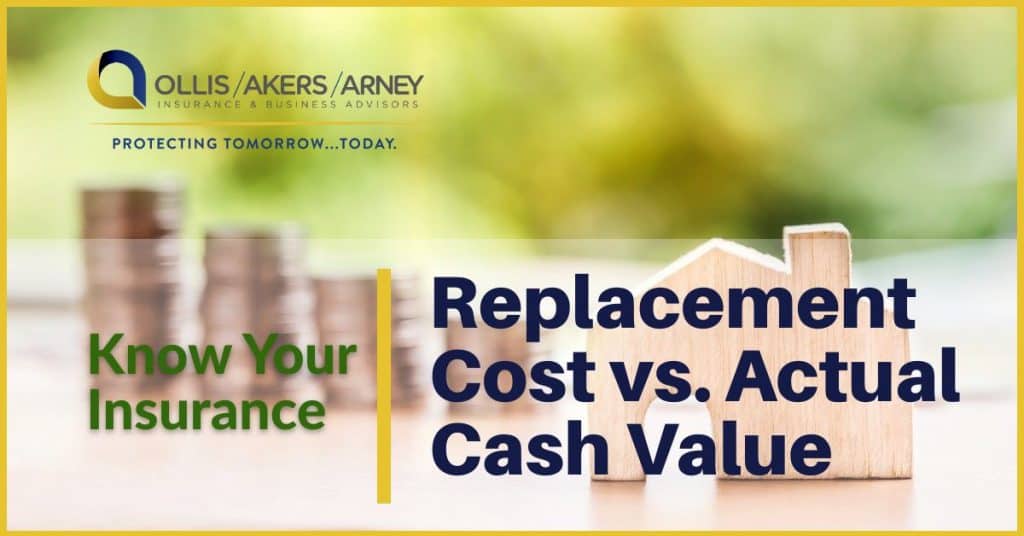Your homeowners insurance policy can offer financial protection in the event of an unexpected disaster involving your home or personal property. But how you will be reimbursed following a claim depends on the type of coverage you have. There are two main valuation methods when it comes to homeowners insurance—replacement cost coverage and actual cash value coverage. By understanding the difference between these valuation methods, you can make informed decisions about your homeowners insurance and secure coverage that meets your needs.
Key Differences Between Replacement Cost and Actual Cash Value
Although replacement cost coverage and actual cash value coverage can both offer financial protection in the event of a claim, the amount that your policy will pay out differs between these two valuation methods. Here are the key differences:
- Replacement cost coverage can offer compensation for the cost of replacing your stolen, damaged or destroyed property with a brand-new version (as long as it’s similar in kind and quality to the original). For example, if your couch is destroyed in a house fire, replacement cost coverage would reimburse you for the cost of purchasing a comparable new couch. In other words, replacement cost coverage will replace your property without any deduction for depreciation.
This form of coverage can be especially beneficial in protecting against major losses, such as significant damage to the physical structure of your home or expensive items within your home. However, keep in mind that replacement cost coverage typically requires you to pay a higher premium. In addition, remember that you will only be compensated up to your policy limit amount—if you experience a covered loss that exceeds your policy limit, you may have to cover the difference. If you are concerned about the risk of a covered loss totaling more than your policy limit, be sure to consult your trusted broker to discuss additional policy options—such as guaranteed replacement cost coverage or extended replacement cost coverage—which can provide further financial protection.
- Actual cash value coverage, on the other hand, can offer compensation for the depreciated value of your stolen, damaged or destroyed property. This value is determined by the age, condition and expected remaining useful life of your property. Under this coverage, you wouldn’t be reimbursed for the full cost of replacing your destroyed couch from the above example. Rather, you would be compensated for current market value of the couch, based on the condition it was in before the fire. That being said, even if you initially purchased the couch several years ago for $2,000, you might only be reimbursed $1,000 for your loss due to depreciation.
Although this form of coverage typically offers reduced compensation in the event of a covered claim, you will likely save money on your policy premium. Actual cash value coverage can be more suitable for individuals that live in low-risk areas (e.g., locations where incidents such as heavy winds, fires or theft are less common) or own fewer expensive items.
Which Coverage Is Best for You?
There are pros and cons to both replacement cost coverage and actual cash value coverage. In order to select the best coverage that meets your specific homeowners insurance policy needs, follow these steps:
- Determine what you can afford by assessing the impact of both coverages on your financial stability. It’s important to consider the difference in premium costs and claim compensation amounts between each form of coverage.
- Create a home inventory checklist (be sure to include photos) of all of your belongings and their original value, as well as an estimate of their current value. This practice will help you better determine which coverage offers the best protection for your unique belongings. Keep in mind that certain high-value items—such as jewelry, collectible items or fine art—won’t be covered by your homeowners insurance policy and will require specialized coverage.
- Calculate how much it would cost to rebuild your home if it were completely destroyed. Include added costs for labor, materials and any new or updated building codes in your community that you would be required to comply with. Avoid making a rough estimate for this cost—be as specific as possible to ensure you know just how much coverage you need.
- Analyze your personal risk. Be sure to select a coverage option that fits within your budget, risk profile and comfort level.
We’re Here to Help
There are several factors to consider when determining which type of coverage is right for you, but you don’t have to navigate this decision alone. Ollis/Akers/Arney Insurance & Business Advisors is here to walk you through your homeowners insurance policy and provide expert guidance regarding which coverage option is best for you, your belongings and your wallet. For further coverage guidance, contact us today.
[elementor-template id=”3836″]
© 2020 Zywave, Inc. All rights reserved. This Know Your Insurance document is not intended to be exhaustive nor should any discussion or opinions be construed as legal advice. Readers should contact legal counsel or an insurance professional for appropriate advice.


